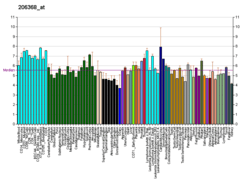CPLX2
Complexin-2 is a protein that in humans is encoded by the CPLX2 gene.[5][6][7]
Proteins encoded by the complexin/synaphin gene family are cytosolic proteins that function in synaptic vesicle exocytosis. These proteins bind syntaxin, part of the SNAP receptor. The protein product of this gene binds to the SNAP receptor complex and disrupts it, allowing transmitter release. Two transcript variants encoding the same protein have been found for this gene.[7]
References
- GRCh38: Ensembl release 89: ENSG00000145920 - Ensembl, May 2017
- GRCm38: Ensembl release 89: ENSMUSG00000025867 - Ensembl, May 2017
- "Human PubMed Reference:". National Center for Biotechnology Information, U.S. National Library of Medicine.
- "Mouse PubMed Reference:". National Center for Biotechnology Information, U.S. National Library of Medicine.
- McMahon HT, Missler M, Li C, Sudhof TC (Nov 1995). "Complexins: cytosolic proteins that regulate SNAP receptor function". Cell. 83 (1): 111–9. doi:10.1016/0092-8674(95)90239-2. PMID 7553862.
- Raevskaya NM, Dergunova LV, Vladychenskaya IP, Stavchansky VV, Oborina MV, Poltaraus AB, Limborska SA (Sep 2005). "Structural organization of the human complexin 2 gene (CPLX2) and aspects of its functional activity". Gene. 359: 127–37. doi:10.1016/j.gene.2005.07.005. PMID 16162394.
- "Entrez Gene: CPLX2 complexin 2".
External links
- Human CPLX2 genome location and CPLX2 gene details page in the UCSC Genome Browser.
Further reading
- Abe T (2002). "[The mechanism of neurotransmitter release: role of synaphin/complexin in synaptic vesicle exocytosis]". Tanpakushitsu Kakusan Koso. 47 (7): 794–800. PMID 12058476.
- Christensen VL, Johnston NP (1978). "Effect of time of day of insemination and the position of the egg in the oviduct on the fertility of turkeys". Poult. Sci. 56 (2): 458–62. doi:10.3382/ps.0560458. PMID 605033.
- Morgans CW, Brandstätter JH, Kellerman J, et al. (1996). "A SNARE complex containing syntaxin 3 is present in ribbon synapses of the retina". J. Neurosci. 16 (21): 6713–21. doi:10.1523/JNEUROSCI.16-21-06713.1996. PMID 8824312.
- Harrison PJ, Eastwood SL (1998). "Preferential involvement of excitatory neurons in medial temporal lobe in schizophrenia". Lancet. 352 (9141): 1669–73. doi:10.1016/S0140-6736(98)03341-8. PMID 9853440.
- Ishizuka T, Saisu H, Odani S, et al. (1999). "Distinct regional distribution in the brain of messenger RNAs for the two isoforms of synaphin associated with the docking/fusion complex". Neuroscience. 88 (1): 295–306. doi:10.1016/S0306-4522(98)00223-1. PMID 10051208.
- Yamada M, Saisu H, Ishizuka T, et al. (1999). "Immunohistochemical distribution of the two isoforms of synaphin/complexin involved in neurotransmitter release: localization at the distinct central nervous system regions and synaptic types". Neuroscience. 93 (1): 7–18. doi:10.1016/S0306-4522(99)00104-9. PMID 10430466.
- Pabst S, Hazzard JW, Antonin W, et al. (2000). "Selective interaction of complexin with the neuronal SNARE complex. Determination of the binding regions". J. Biol. Chem. 275 (26): 19808–18. doi:10.1074/jbc.M002571200. PMID 10777504.
- Eastwood SL, Cotter D, Harrison PJ (2001). "Cerebellar synaptic protein expression in schizophrenia". Neuroscience. 105 (1): 219–29. doi:10.1016/S0306-4522(01)00141-5. PMID 11483314.
- Eastwood SL, Harrison PJ (2001). "Synaptic pathology in the anterior cingulate cortex in schizophrenia and mood disorders. A review and a Western blot study of synaptophysin, GAP-43 and the complexins". Brain Res. Bull. 55 (5): 569–78. doi:10.1016/S0361-9230(01)00530-5. PMID 11576753.
- Pabst S, Margittai M, Vainius D, et al. (2002). "Rapid and selective binding to the synaptic SNARE complex suggests a modulatory role of complexins in neuroexocytosis". J. Biol. Chem. 277 (10): 7838–48. doi:10.1074/jbc.M109507200. PMID 11751907.
- Sawada K, Young CE, Barr AM, et al. (2002). "Altered immunoreactivity of complexin protein in prefrontal cortex in severe mental illness". Mol. Psychiatry. 7 (5): 484–92. doi:10.1038/sj.mp.4000978. PMID 12082566.
- Hu K, Carroll J, Rickman C, Davletov B (2003). "Action of complexin on SNARE complex". J. Biol. Chem. 277 (44): 41652–6. doi:10.1074/jbc.M205044200. PMID 12200427.
- Strausberg RL, Feingold EA, Grouse LH, et al. (2003). "Generation and initial analysis of more than 15,000 full-length human and mouse cDNA sequences". Proc. Natl. Acad. Sci. U.S.A. 99 (26): 16899–903. doi:10.1073/pnas.242603899. PMC 139241. PMID 12477932.
- Edwardson JM, Wang CT, Gong B, et al. (2003). "Expression of mutant huntingtin blocks exocytosis in PC12 cells by depletion of complexin II". J. Biol. Chem. 278 (33): 30849–53. doi:10.1074/jbc.M304615200. PMID 12807877.
- Ota T, Suzuki Y, Nishikawa T, et al. (2004). "Complete sequencing and characterization of 21,243 full-length human cDNAs". Nat. Genet. 36 (1): 40–5. doi:10.1038/ng1285. PMID 14702039.
- Gerhard DS, Wagner L, Feingold EA, et al. (2004). "The status, quality, and expansion of the NIH full-length cDNA project: the Mammalian Gene Collection (MGC)". Genome Res. 14 (10B): 2121–7. doi:10.1101/gr.2596504. PMC 528928. PMID 15489334.
- Eastwood SL, Harrison PJ (2005). "Decreased expression of vesicular glutamate transporter 1 and complexin II mRNAs in schizophrenia: further evidence for a synaptic pathology affecting glutamate neurons". Schizophr. Res. 73 (2–3): 159–72. doi:10.1016/j.schres.2004.05.010. PMID 15653259.
- DiProspero NA, Chen EY, Charles V, et al. (2005). "Early changes in Huntington's disease patient brains involve alterations in cytoskeletal and synaptic elements". J. Neurocytol. 33 (5): 517–33. doi:10.1007/s11068-004-0514-8. PMID 15906159.
This article is issued from Wikipedia. The text is licensed under Creative Commons - Attribution - Sharealike. Additional terms may apply for the media files.




